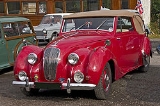
Lagonda 2.6-Litre
Encyclopedia
The first new automobile produced by Lagonda
after its purchase by David Brown
in 1947 was the 2.6-Litre. It was named for the new high-tech straight-6
engine which debuted with the car. The so-called Lagonda Straight-6 engine
was designed by Walter Owen Bentley and would propel Lagonda's new parent company, Aston Martin
, to fame.
The 2.6-Litre was a larger car than the Aston Martins and was available as either a 4-door closed car or from 1949 2-door convertible "Drophead Coupé", both with 4 seats. The drophead was bodied by Tickford
, at the time not part of Aston Martin. A Mark II version appeared in 1952, in closed form only, with engine power increased to 125 bhp.
The car sold reasonably well, in spite of being an expensive car and being launched so soon after the war, with 510 examples made when production ended in 1953.
The car had a separate chassis and all independent suspension using coil springs at the front and torsion bars at the rear. At introduction it was believed to be the only all-independently sprung British car. The Lockheed brakes had 12 in (305 mm) drums at the front and 11 in (279 mm) at the rear with the latter being mounted inboard. Rack and pinion steering was used.
A drophead version tested by The Motor
magazine in 1949 had a top speed of 90.2 mph (145.2 km/h) and could accelerate from 0-60 mph (96.6 km/h) in 17.6 seconds. A fuel consumption of 17 mpgimp was recorded. The test car cost £3,420 including taxes.
Lagonda
Lagonda is a British luxury car marque, founded as a company in 1906 in Staines, Middlesex by a former opera singer from Ohio, but of Scottish ancestry, named Wilbur Gunn . He named the company after a river near the town of his birth, Springfield, Ohio, United States...
after its purchase by David Brown
David Brown (entrepreneur)
Sir David Brown was an English entrepreneur, managing director of his family firm David Brown Limited and one time owner of shipbuilders Vosper Thornycroft and automobile manufacturer Aston Martin....
in 1947 was the 2.6-Litre. It was named for the new high-tech straight-6
Straight-6
The straight-six engine or inline-six engine is a six-cylinder internal combustion engine with all six cylinders mounted in a straight line along the crankcase...
engine which debuted with the car. The so-called Lagonda Straight-6 engine
Lagonda Straight-6 engine
The Lagonda Straight-6 is a famous automobile engine used by Aston Martin and Lagonda marques in the 1950s. Designed by Walter Owen Bentley of Bentley Motors Limited, it vaulted Aston Martin to fame as a maker of desirable sports and racing cars.-History:...
was designed by Walter Owen Bentley and would propel Lagonda's new parent company, Aston Martin
Aston Martin
Aston Martin Lagonda Limited is a British manufacturer of luxury sports cars, based in Gaydon, Warwickshire. The company name is derived from the name of one of the company's founders, Lionel Martin, and from the Aston Hill speed hillclimb near Aston Clinton in Buckinghamshire...
, to fame.
The 2.6-Litre was a larger car than the Aston Martins and was available as either a 4-door closed car or from 1949 2-door convertible "Drophead Coupé", both with 4 seats. The drophead was bodied by Tickford
Tickford
Tickford is an automobile engineering and testing company with a history of coachbuilding and tuning and is famous for such products as the 140 mph Tickford Turbo Capri.-Early years:...
, at the time not part of Aston Martin. A Mark II version appeared in 1952, in closed form only, with engine power increased to 125 bhp.
The car sold reasonably well, in spite of being an expensive car and being launched so soon after the war, with 510 examples made when production ended in 1953.
The car had a separate chassis and all independent suspension using coil springs at the front and torsion bars at the rear. At introduction it was believed to be the only all-independently sprung British car. The Lockheed brakes had 12 in (305 mm) drums at the front and 11 in (279 mm) at the rear with the latter being mounted inboard. Rack and pinion steering was used.
A drophead version tested by The Motor
The Motor (magazine)
The Motor was a British weekly car magazine founded on 28 January 1903....
magazine in 1949 had a top speed of 90.2 mph (145.2 km/h) and could accelerate from 0-60 mph (96.6 km/h) in 17.6 seconds. A fuel consumption of 17 mpgimp was recorded. The test car cost £3,420 including taxes.

